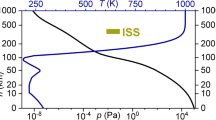Abstract
Since the barometer measures the weight of the overlying atmosphere, it follows by the law of Gladstone and Dale that the height integral∫(n#x2212;1) of the atmospheric refractivity for light, taken from ground level up to the top of the atmosphere, is directly proportional to ground pressure. The refractivity integral, therefore, can be determined without detailed knowledge of the height distribution of the refractive index, which not only simplifies the derivation of refraction formulas in which atmospheric models have been used hitherto, but also improves their accuracy. For zenith distances not exceeding about 75 degrees, the correction for astronomical refraction will be given by the standard formula
wherez is the apparent zenith distance,p is the total pressure ande is the partial pressure of water vapour, both in millibars, andT is the absolute temperature in degrees Kelvin Part II of the paper contains further applications of the theory to refraction problems in satellite geodesy, including the photogrammetric refraction and the atmospheric corrections in the ranging of artificial satellites.
Similar content being viewed by others
Author information
Authors and Affiliations
Additional information
Cet article sera publié en trois fois: Bulletin Géodésique nos 105, 106 et 107.
Rights and permissions
About this article
Cite this article
Saastamoinen, J. Contributions to the theory of atmospheric refraction. Bull. Geodesique 105, 279–298 (1972). https://doi.org/10.1007/BF02521844
Published:
Issue Date:
DOI: https://doi.org/10.1007/BF02521844




